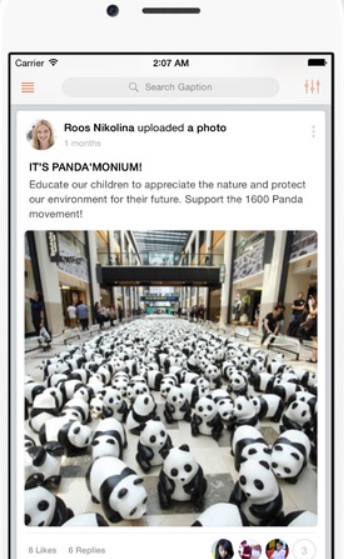Malaysian startup with a social network … that pays
By Lum Ka Kay January 18, 2016
- Rewards users by sharing ad revenue with them
- Subscription-based model for content creators

IF you’re a millennial, you’re probably deep into social networks like Snapchat, Instagram and Vine; while the older ones still swear by Facebook. One Malaysian startup believes it can convince social media users to jump onto its own platform.
Its (literal) selling point? It helps you make money off your social media activity.
Gaptionize Services Sdn Bhd intends to create a new social environment where users are ‘rewarded’ for sharing content such as images, texts or videos, on its platform Gaption – from the words ‘gap’ and ‘traction.’
The company officially launched its iOS app in September 2015.
“Anyone can be a content creator, and Gaption is a social platform that rewards these content creators. We reward users by sharing our advertising revenue with them,” says founder and chief executive officer Kenneth Ho (pic above).
The idea for Gaption came about when a musician friend of his complained that ‘starving artistes’ never make enough money to do what they like to do.
“And I find the same problem applies to authors and other creative content creators as well, so I started thinking if there was a way to help these people,” recalls Ho, speaking to Digital News Asia (DNA) in Petaling Jaya recently.
Many people spend a lot of time sharing their content on social media, “so if we could convert some of the time spent into income for these people, it would be great.
“And so when we started, it was more of users earning royalties based on their social network activities,” he adds, although he did not explain how exactly the reward system works.
Certainly, Gaption has enough traction that Ho is claiming 80,000 downloads for its iOS app, with work ongoing on an Android version.
Subscription-based model

But as Gaption grew and matured over time, some users started to request exclusivity.
“Some users started to ask: ‘I create so much content on Gaption, wouldn’t it be better if I could make my content exclusive to my subscribers only?’ ” he says.
This prompted Ho to come up with a subscription-based model for content creators, which will be launched later this month. It is currently undergoing testing.
“Basically, users can choose to limit their content to their subscribers only. Subscribers will have to pay US$4.99 per month in order to view the content from their favourite content creators,” he says.
He argues that the subscription-based model will serve as an endorsement of these content creators since they will get paid for what they are doing. Meanwhile, Gaption takes a 50% cut of the subscription fee.
This is actually a pivot. Originally, the Gaption revenue model was to get brands to advertise their products and services.
“I’ll be honest with you – we had problems convincing advertisers to come on board, which is why we are pivoting to this subscription-based model,” says Ho.
“Advertising is a very enterprise-based approach, whereas the subscription model is a very consumer-based approach,” he adds.
Ho targets to get at least 1% of Gaption’s active users on the newly-launched subscription model, with ‘active users’ being those who login to the app at least once a week.
“38% of our users are active weekly,” he says, adding that Gaption’s 80,000 users come from all over the world, with the biggest proportion coming from the United States – 28%. Users from Malaysia and Singapore contribute 25% each to the total.
How many of its 80,000 users are actual content creators, however?
Stressing that everyone on Gaption is a content creator, Ho says, “If you’re talking about people who are creating content specifically to get paid subscribers and who have the ability to receive subscriptions, it’s about 50 people now.
“We are still testing this feature with them,” he adds.
Target audience is women
 But how does it really work and how can it compete against social media giants like Facebook, Twitter and Instagram, which have hundreds of millions users?
But how does it really work and how can it compete against social media giants like Facebook, Twitter and Instagram, which have hundreds of millions users?
Ho argues that Gaption works like any other social media platform where people can share text, images, videos and even chat with friends.
“So rather than spending all your time on social networking platforms that don’t pay you anything, at least here, just by being active, you can earn royalties.
“And if you want to bring it one step further, where you are certain that you can bring really good content to your subscribers, you can make even more money through the subscription model.
“The problem with Facebook nowadays is that younger people tend to view it as a news platform. I mean, Facebook is great, but millennials don’t find it interesting.
“For non-millennials like me, we started using Facebook because our friends were there, but for the millennials, their friends are on Snapchat, Instagram and Vine instead.
“And what Gaption offers is that users can do all this on Gaption without having several accounts,” he adds.
Gaption discourages users from spamming their social media content with links. It is also “idiot-proof,” Ho argues, saying users don’t need to learn anything about HTML or other technical skills to share content with their friends.
“Our target audience is actually women. Over 60% of our users are women, and we find that they have more influencing power because they will recommend Gaption to other women as well,” he adds.
The app is one thing, but as a social media network, Gaption also needs to have the infrastructure to operate. According to Ho, it runs on Amazon Web Services.
The platform is built on a distributed compute and storage hosting architecture, aimed at ensuring high scalability while retaining performance, security, and optimising costs, he says.
“All data is securely hosted, encrypted, and distributed throughout multiple availability zones, and only made available securely to authorised devices,” he adds.
It may be a tough sell getting people to move to a new social media platform – especially since they would have already built up networks and contacts on their current platforms – but Gaption has at least one key believer.
Cradle Fund Sdn Bhd, the Ministry of Finance agency that is tasked with developing tech startups, awarded it a CIP 150 (Cradle Investment Programme) grant worth RM150,000 (about US$35,000 at current rates) as pre-seed funding in 2015.
Ho himself started the company on his own funds, although he declines to put a figure. He is now looking to raise at least RM250,000 (about US$60,000) for Gaption’s seed round. In the meantime, he hopes to grow Gaption’s user base to three million within the next 12 months.
But the question remains, can Gaption really wean users from their current social media platforms?
Related Stories:
Social media: Vox populi when terror strikes
Two-man startup Gigfairy secures US$28K pre-seed funding
Start-up Placety wants to share your favourite spots
For more technology news and the latest updates, follow us on Twitter, LinkedIn or Like us on Facebook.


